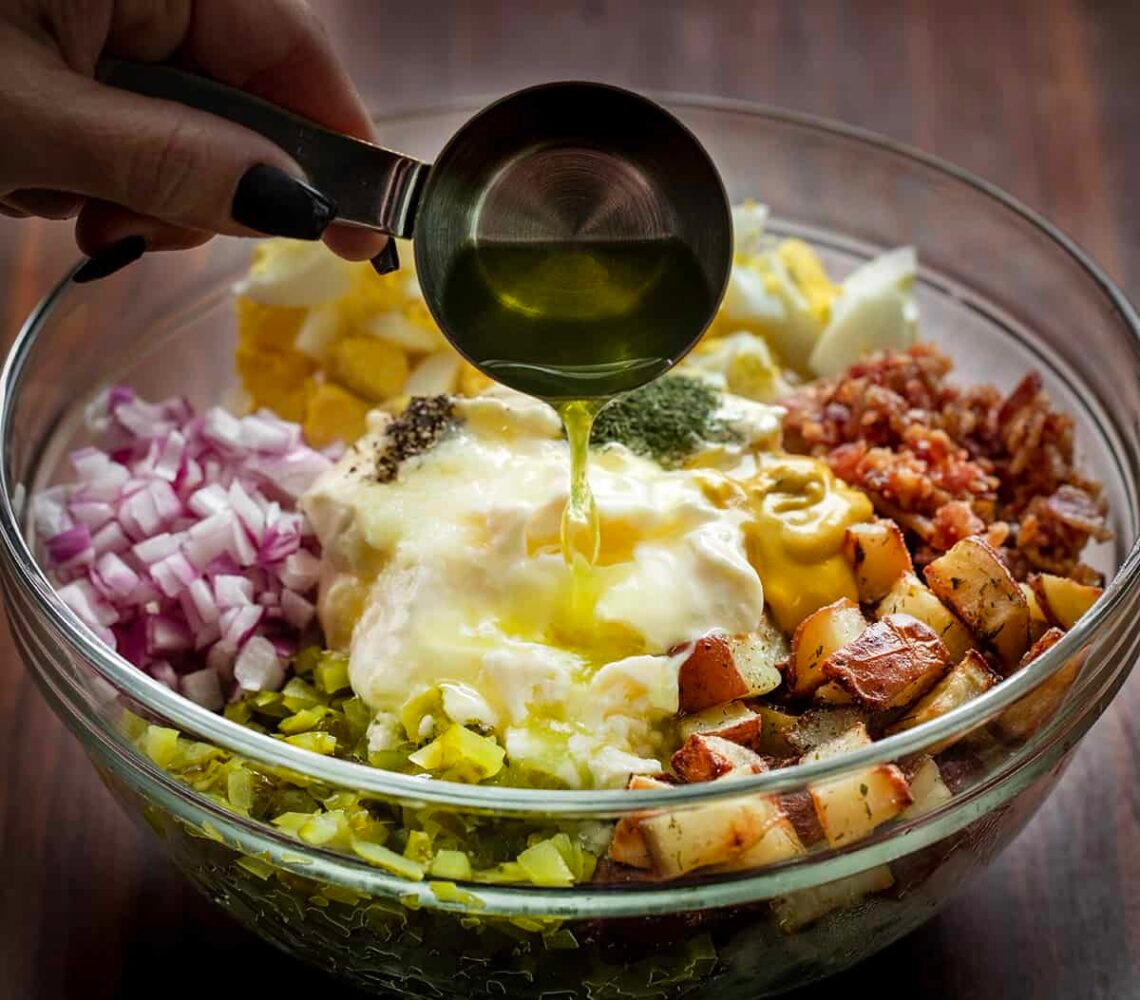Introduction
Potato salad is a beloved side dish, gracing tables at picnics, barbecues, and family gatherings worldwide. Its creamy texture and versatile flavor profile make it a crowd-pleaser, but sometimes, you want to elevate the classic recipe with a bold, tangy twist. Enter the Dill Pickle Potato Salad—a vibrant, zesty variation that combines the comforting familiarity of potato salad with the sharp, briny kick of dill pickles. This recipe not only delivers on flavor but also offers a refreshing change that will have your guests coming back for seconds. In this comprehensive guide, we’ll walk you through the recipe, tips for perfect execution, variations, and the cultural significance of potato salad, all while keeping the dill pickle front and center.
Ingredients
To create a Dill Pickle Potato Salad that serves 8–10 people, you’ll need the following ingredients:
For the Salad:
- Potatoes: 3 pounds (about 6–8 medium) Yukon Gold or red potatoes, scrubbed clean
- Dill Pickles: 1 cup finely chopped (about 4–5 medium pickles)
- Celery: 2 stalks, finely chopped (about ½ cup)
- Red Onion: ½ cup finely chopped
- Hard-Boiled Eggs: 4 large, peeled and chopped (optional, for added richness)
- Fresh Dill: ¼ cup finely chopped, plus extra for garnish
For the Dressing:
- Mayonnaise: 1 cup (use full-fat for creaminess or light for a healthier option)
- Sour Cream: ½ cup (adds tang and smoothness)
- Pickle Juice: ¼ cup (from the dill pickle jar, for extra zing)
- Dijon Mustard: 2 tablespoons (for a slight spicy depth)
- Apple Cider Vinegar: 1 tablespoon (enhances acidity)
- Garlic Powder: 1 teaspoon
- Salt: 1 teaspoon, or to taste
- Black Pepper: ½ teaspoon, freshly ground
- Sugar: 1 teaspoon (optional, to balance acidity)
Equipment:
- Large pot for boiling potatoes
- Colander
- Large mixing bowl
- Small bowl for dressing
- Cutting board and knife
- Measuring cups and spoons
- Spatula or large spoon for mixing
Instructions
Step 1: Prepare the Potatoes
- Boil the Potatoes: Place the whole, unpeeled potatoes in a large pot and cover with cold water. Add a generous pinch of salt to the water. Bring to a boil over medium-high heat, then reduce to a simmer. Cook for 15–20 minutes, or until the potatoes are fork-tender but not falling apart.
- Cool and Peel: Drain the potatoes in a colander and let them cool slightly until they’re safe to handle. Peel the potatoes if desired (Yukon Gold skins are thin and can be left on for texture; red potato skins add color). Cut into bite-sized cubes (about ½-inch) and place in a large mixing bowl.
- Season While Warm: Sprinkle the warm potato cubes with 1 tablespoon of apple cider vinegar and a pinch of salt. This step enhances flavor absorption. Let the potatoes cool completely to room temperature.
Step 2: Prepare the Add-Ins
- Chop the Vegetables: Finely chop the dill pickles, celery, and red onion. The small size ensures even distribution and a pleasant texture in every bite.
- Chop the Eggs: If using, peel and chop the hard-boiled eggs into small pieces.
- Chop the Dill: Finely chop the fresh dill, reserving a few sprigs for garnish.
Step 3: Make the Dressing
- In a small bowl, whisk together the mayonnaise, sour cream, pickle juice, Dijon mustard, apple cider vinegar, garlic powder, salt, black pepper, and sugar (if using). Taste and adjust seasoning as needed—add more pickle juice for extra tang or salt for balance.
- The dressing should be creamy yet pourable. If it’s too thick, add a splash of pickle juice or water to thin it out.
Step 4: Assemble the Salad
- Add the chopped pickles, celery, red onion, hard-boiled eggs (if using), and fresh dill to the bowl with the cooled potatoes.
- Pour the dressing over the potato mixture. Using a spatula or large spoon, gently fold the ingredients together until everything is evenly coated. Be careful not to mash the potatoes.
- Taste and adjust seasoning, adding more salt, pepper, or pickle juice as desired.
Step 5: Chill and Serve
- Cover the bowl with plastic wrap and refrigerate the potato salad for at least 2 hours, preferably overnight, to allow the flavors to meld.
- Before serving, give the salad a gentle stir. Garnish with extra chopped dill and a few pickle slices for visual appeal.
- Serve chilled or at cool room temperature alongside grilled meats, sandwiches, or as part of a picnic spread.
Tips for Success
- Choose the Right Potatoes: Yukon Gold or red potatoes are ideal because they hold their shape well and have a creamy texture. Avoid starchy potatoes like Russets, which can become mushy.
- Don’t Overcook: Test the potatoes frequently while boiling. They should be tender but firm enough to cube without crumbling.
- Balance the Tang: The pickle juice and vinegar add acidity, so taste the dressing before combining it with the salad. If it’s too sharp, a touch of sugar or more mayonnaise can soften the bite.
- Make Ahead: This salad tastes better after chilling, as the flavors deepen over time. Prepare it a day in advance for best results.
- Customize Texture: For a chunkier salad, cut the potatoes and vegetables into larger pieces. For a creamier texture, slightly mash some of the potatoes before adding the dressing.
Variations
The Dill Pickle Potato Salad is highly adaptable. Here are some creative twists to suit different tastes or dietary needs:
- Bacon and Dill Pickle Potato Salad: Add ½ cup of crispy, crumbled bacon for a smoky, savory element.
- Vegan Dill Pickle Potato Salad: Swap the mayonnaise for vegan mayo, use plant-based sour cream, and omit the eggs. Add chopped avocado for creaminess.
- Spicy Dill Pickle Potato Salad: Include 1–2 finely chopped jalapeños or a dash of hot sauce in the dressing for a fiery kick.
- German-Inspired Dill Pickle Potato Salad: Replace the mayonnaise-based dressing with a warm vinaigrette made of pickle juice, mustard, olive oil, and bacon fat. Serve warm or at room temperature.
- Herb-Forward Version: Incorporate additional fresh herbs like parsley, chives, or tarragon for a more aromatic profile.
Nutritional Information (Per Serving, Approx.)
- Calories: 250–300 kcal (varies based on mayonnaise type and egg inclusion)
- Fat: 15–20g
- Carbohydrates: 25g
- Protein: 5g
- Sodium: 600–800mg (due to pickles and salt)
For a lighter version, use low-fat mayonnaise and sour cream, or reduce the dressing quantity and increase the pickle juice for flavor.
The Cultural Significance of Potato Salad
Potato salad is more than just a side dish—it’s a cultural touchstone in many cuisines. In the United States, it’s a staple at summer barbecues and Fourth of July celebrations, often evoking nostalgia for family recipes passed down through generations. The creamy, mayonnaise-based version is iconic in American cuisine, but variations exist worldwide:
- Germany: Known for its vinegar-based potato salads, often served warm with bacon and mustard.
- Russia: The “Olivier” salad, a potato salad with diced vegetables, meats, and mayonnaise, is a New Year’s tradition.
- Southern United States: Mustard-based potato salads with a tangy, yellow hue are popular.
The addition of dill pickles in this recipe nods to Eastern European influences, where pickled vegetables are a dietary staple. Dill pickles bring a bright, briny flavor that complements the richness of the potatoes and dressing, making this version both familiar and excitingly different.
Pairing Suggestions
Dill Pickle Potato Salad pairs beautifully with a variety of dishes:
- Grilled Meats: Burgers, hot dogs, or barbecue ribs complement the salad’s tangy profile.
- Sandwiches: Serve alongside deli sandwiches, pulled pork sliders, or fried chicken sandwiches.
- Vegetarian Options: Pair with grilled vegetable skewers or a black bean burger for a balanced meal.
- Beverages: A crisp lemonade, iced tea, or light beer enhances the salad’s refreshing qualities.
Storage and Leftovers
- Refrigeration: Store the potato salad in an airtight container in the refrigerator for up to 4–5 days. Do not leave it at room temperature for more than 2 hours to prevent spoilage.
- Freezing: Potato salad does not freeze well due to the mayonnaise and potatoes, which can separate or become grainy when thawed.
- Repurposing Leftovers: Use leftover salad as a filling for stuffed baked potatoes, a topping for grain bowls, or a spread in wraps with greens and protein.
Troubleshooting Common Issues
- Too Watery: If the salad becomes watery after chilling, drain excess liquid and stir in a bit more mayonnaise or sour cream.
- Bland Flavor: Add more pickle juice, salt, or fresh dill to boost the flavor.
- Mushy Potatoes: Ensure potatoes are not overcooked, and handle them gently when mixing.
Conclusion
Dill Pickle Potato Salad is a delightful fusion of creamy, tangy, and fresh flavors that elevates the traditional potato salad to new heights. Whether you’re hosting a summer barbecue, attending a potluck, or simply craving a comforting side dish, this recipe is sure to impress. With its make-ahead convenience and customizable nature, it’s a versatile addition to any menu. So, grab some dill pickles, boil those potatoes, and get ready to savor a dish that’s as bold as it is nostalgic.






